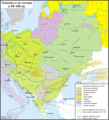ファイル:Slav-7-8-obrez.png
表示

このプレビューのサイズ: 544 × 599 ピクセル。 その他の解像度: 218 × 240 ピクセル | 436 × 480 ピクセル | 698 × 768 ピクセル | 930 × 1,024 ピクセル | 1,860 × 2,048 ピクセル | 3,051 × 3,359 ピクセル。
元のファイル (3,051 × 3,359 ピクセル、ファイルサイズ: 339キロバイト、MIME タイプ: image/png)
ファイルの履歴
過去の版のファイルを表示するには、その版の日時をクリックしてください。
| 日付と時刻 | サムネイル | 寸法 | 利用者 | コメント | |
|---|---|---|---|---|---|
| 現在の版 | 2023年8月12日 (土) 15:13 |  | 3,051 × 3,359 (339キロバイト) | Gyalu22 | Reverted to version as of 13:16, 23 October 2022 (UTC) Look at the atlas, don't do your own research |
| 2023年6月1日 (木) 17:43 |  | 3,051 × 3,359 (309キロバイト) | Shibbolet3579 | enice was still in the Byzantine Empire at this time. Avars were also present around Vienna and in central Transylvania, evidenced by graves & toponyms. There was a linguistic contact between Albanians and Vlachs, evidenced by the non-Slavic words present in both languages. Placed the Etelköz of the Magyars and the Crimean byzantine Greeks. South-Slavic toponyms (as Trnava for "tip, hillock, mound") evidenced a South-Slavic presence in southern Transylvania. Concerning the Eastern romance spe... | |
| 2022年10月23日 (日) 13:16 |  | 3,051 × 3,359 (339キロバイト) | Gyalu22 | Reverted bad faith edit, restored to version as of 26 July 2011. The Westermanns Atlas is an irrelevant source for the previous map, as only the Southern Carpathians are shown as possibly inhabited by the Wallachians. | |
| 2014年4月28日 (月) 15:09 |  | 3,051 × 3,359 (302キロバイト) | Spiridon Ion Cepleanu | Bulgarian kingdom & east-romance vlachs according with the universitary atlases of history and the Grosser Atlas zur Weltgeschichte, dir. Hans-Erich Stier, Westermann, 1985, ISBN 3-14-10-0919-8, pp. 50, 55-57, 61 & 64. | |
| 2011年7月26日 (火) 18:27 |  | 3,051 × 3,359 (339キロバイト) | Koryakov Yuri | The map's resolution is drastically decreased. Undo | |
| 2011年7月26日 (火) 04:53 |  | 544 × 599 (329キロバイト) | Spiridon Ion Cepleanu | On the original version of this map, the eastern romance language-spoken populations ("Vlachs" or "Volokhs") are draw only in a little area around Sredets (today Sofia), according with only one of the POVs, called "Röslerian" (since Eduard Robert Rösler | |
| 2008年3月10日 (月) 13:52 |  | 3,051 × 3,359 (339キロバイト) | Koryakov Yuri | {{Information |Description= |Source= self-made |Date=March 2008 |Author= Koryakov Yuri |other_versions= }} == Licensing == {{self|cc-by-sa-3.0}} Category:Maps of the history of Russia in Russian [[Category:Maps |
ファイルの使用状況
以下のページがこのファイルを使用しています:
グローバルなファイル使用状況
以下に挙げる他のウィキがこの画像を使っています:
- ar.wikipedia.org での使用状況
- arz.wikipedia.org での使用状況
- azb.wikipedia.org での使用状況
- ba.wikipedia.org での使用状況
- be-tarask.wikipedia.org での使用状況
- be.wikipedia.org での使用状況
- bg.wikipedia.org での使用状況
- ce.wikipedia.org での使用状況
- cs.wikipedia.org での使用状況
- cv.wikipedia.org での使用状況
- da.wikipedia.org での使用状況
- de.wikipedia.org での使用状況
- en-two.iwiki.icu での使用状況
このファイルのグローバル使用状況を表示する。


